This post may contain affiliate links. Please read our disclosure policy.
Making warm and crusty homemade bread is easier than you’d imagine with this no knead skillet cheese bread. Perfect for dunking in warm soup, the cheese and parsley add extra yummy goodness!
For those who love bread-making, you’ll also want to try my popular flatbread recipe or this creamy spoon bread! I’m confident that both will be your new favorites!
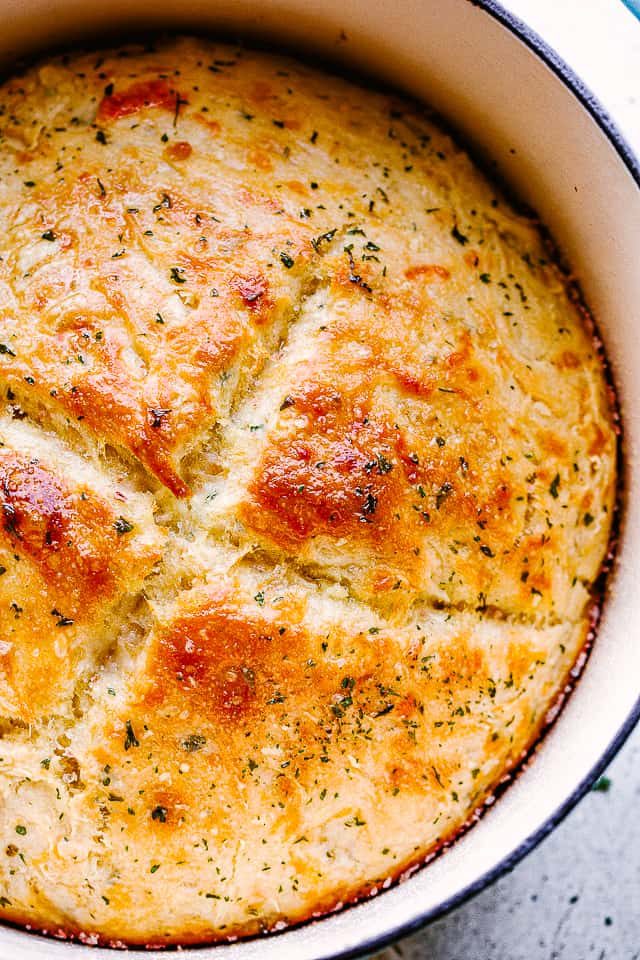
Why I Love No Knead Bread
- Easy. If you’ve ever felt intimidated by the idea of making your own artisan bread, this is the bread to try. You don’t need a fancy bread maker or any tools other than a mixing bowl, wooden spoon, and a skillet.
- Cheesy. If you are a cheese lover, you will completely fall in love with this homemade bread. It’s cheesy, savory, and 100% satisfying.
- The crust. This cheese bread recipe has the perfect consistency, including a golden and crisp crust with a tender interior.
- Fresh. There’s something special about homemade bread just out of the oven. It’s fresh and fills your entire house with that delicious bakery smell.
What is No Knead Bread?
No knead bread is a simple bread-making method that requires no kneading. The dough is mixed and allowed to rise slowly, relying on time rather than kneading to develop gluten. This results in bread with a hearty crust and soft interior, and it’s perfect for those who want homemade bread with minimal effort.
Recipe Ingredients
- Luke Warm Water: Activates the yeast.
- Active Dry Yeast: Causes the dough to rise.
- Salt: Enhances flavor.
- All-Purpose Flour: For this recipe, I use a little over 4 cups of flour.
- Garlic Powder: Adds a savory, garlicky flavor.
- Onion Powder: Provides a subtle onion taste.
- Shredded Cheddar Cheese: Adds a rich, cheesy flavor and texture. Other melting cheeses like mozzarella or gouda can be substituted.
- Olive Oil: Used to coat the skillet and the dough, adding flavor and a crispy crust.
- Coarse Salt: Sprinkled on top for extra flavor and texture. Flaky sea salt is a good substitute.
- Dried Parsley: Used as a topping for additional flavor and visual appeal. Other herbs can also be used.
How to Make No Knead Cheese Bread


- Make the dough. Combine your water and yeast in a large mixing bowl. Add a cup of flour and salt and stir it all together. Stir in the garlic powder, onion powder, and cheese. Gradually add the remaining flour and stir everything until it is all well combined.
- Rise. Cover the bowl with plastic wrap and let your dough rise for 1 hour.
- Prepare. Grab a cast iron skillet and coat the bottom and sides with olive oil. Lightly flour your hands and transfer the dough to the skillet. Shape the dough into a round disk, cover it with a towel, and let it stand for 30 minutes.
- Preheat. While the dough rests, preheat your oven to 400˚F.
- Bake. Drizzle 1 tablespoon olive oil over the top of the dough and sprinkle it with salt and parsley. Score the top of the loaf with a knife in a criss-cross pattern. Bake it for 30 minutes or until the top is a golden brown.
- Cool and Serve. Remove the cheese bread from the oven and immediately turn it out onto a cooling rack. Let it completely cool. Then, cut it and serve it with this butternut squash soup or a side of beer battered chicken!
Recipe Tips
- Cool it on a wire rack. To keep this skillet bread from getting soggy, remove it from the skillet as soon as you pull it out of the oven and transfer it to a wire rack.
- Skillet options. You do not need a skillet to make this bread. I know, it’s in the recipe title – but trust me, here. If you do not have a cast iron skillet, simply use a round stoneware baking dish instead!
- Use good cheddar. For better flavor, opt for a better quality cheddar cheese. You can even shred the cheese yourself.
- Double the recipe. You can double this cheese bread recipe, but don’t forget you’ll also need a bigger skillet. I recommend a 12-inch skillet for a double batch.
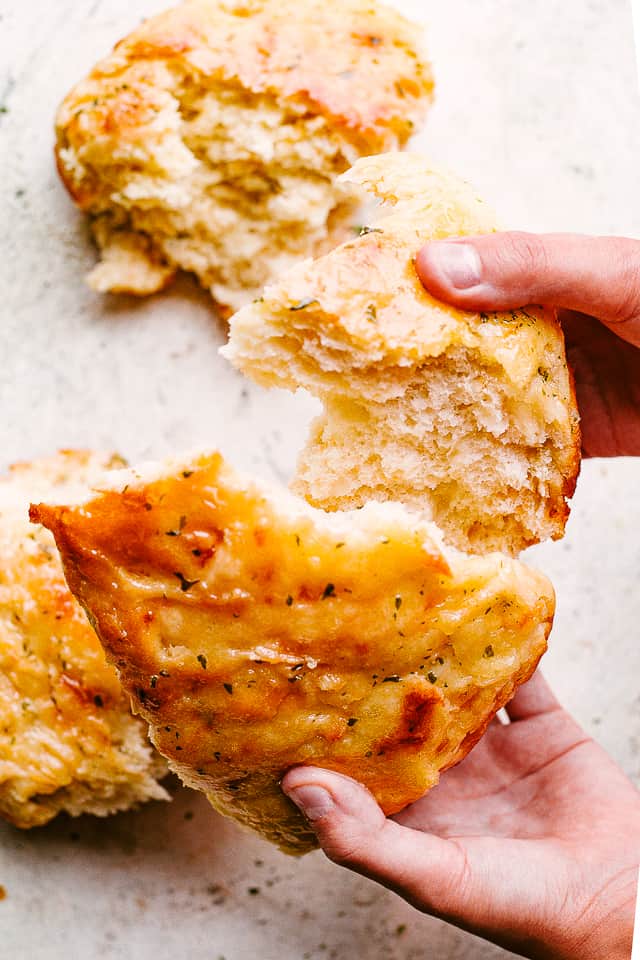
Serving Suggestions
Obviously, this no knead cheese bread goes great with a bowl of our creamy ravioli soup and a side of a salmon blt salad. It’s also great with hearty beef Guinness stew and pot roast. But don’t count it out on the side of a pasta dish, either. This chicken bacon ranch pasta or my creamy seafood pasta is fantastic. Basically, anything that is saucy is a perfect match for this bread.
How to Store Leftovers
The bread can be stored in a zip-top bag in a cool, dry place for up to 3 days. It can also be frozen for about 3 months.
More Homemade Bread Recipes
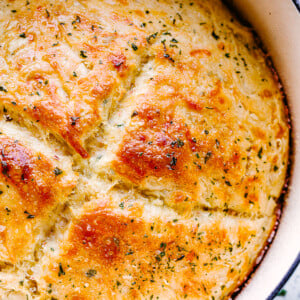
No Knead Cheese Bread
Ingredients
- 2 cups luke warm water
- 2¼ teaspoons active dry yeast
- ½ teaspoon salt
- 4⅓ cups all purpose flour
- 1½ teaspoons garlic powder
- ½ teaspoon onion powder
- 1 cup shredded cheddar cheese
- 2 tablespoons olive oil, divided
- course salt
- dried parsley
Instructions
- Combine water and yeast in a large mixing bowl.
- Add 1 cup flour and ½ teaspoon salt to the yeast mixture; stir with a wooden spoon until combined. Stir in the garlic powder, onion powder, and cheese.
- Add remaining flour, one cup at a time, stirring until well combined. Cover the bowl with plastic wrap and let it rise for 1 hour.
- In the meantime, add 1 tablespoon of olive oil to an 8-inch cast iron skillet and coat the bottom and sides of the skillet with the oil.
- Lightly flour your hands and transfer the dough to the skillet. Shape the dough into a round disk; cover with a towel and let it stand for 30 minutes.
- Preheat the oven to 400˚F.
- Drizzle 1 tablespoon of olive oil over the top of the dough and sprinkle it with salt and parsley. Then, score the top of the loaf with a knife.
- Bake for 30 minutes or until the top is golden brown.
- Remove the bread from the oven and immediately turn it out onto a cooling rack.
- Let it completely cool before cutting into it.
Notes
- To freeze the dough: Make the dough as instructed and let it rise for 1 hour, per the recipe. Once risen, form the dough into a ball, wrap it in plastic wrap, and then place it in a freezer-friendly container and keep it frozen for up to a month. When ready, thaw the frozen dough on the kitchen counter, let it rise, and bake as directed.
Nutrition
Nutritional info is an estimate and provided as courtesy. Values may vary according to the ingredients and tools used. Please use your preferred nutritional calculator for more detailed info.
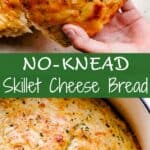
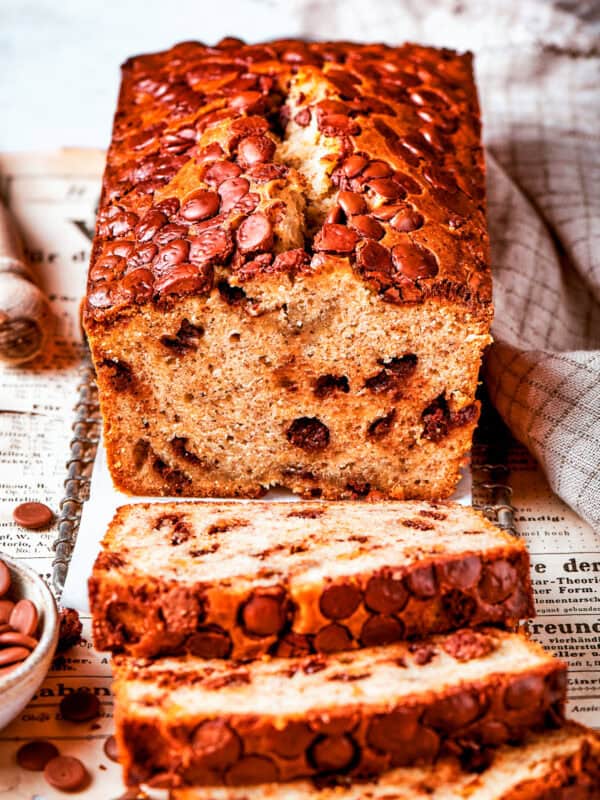
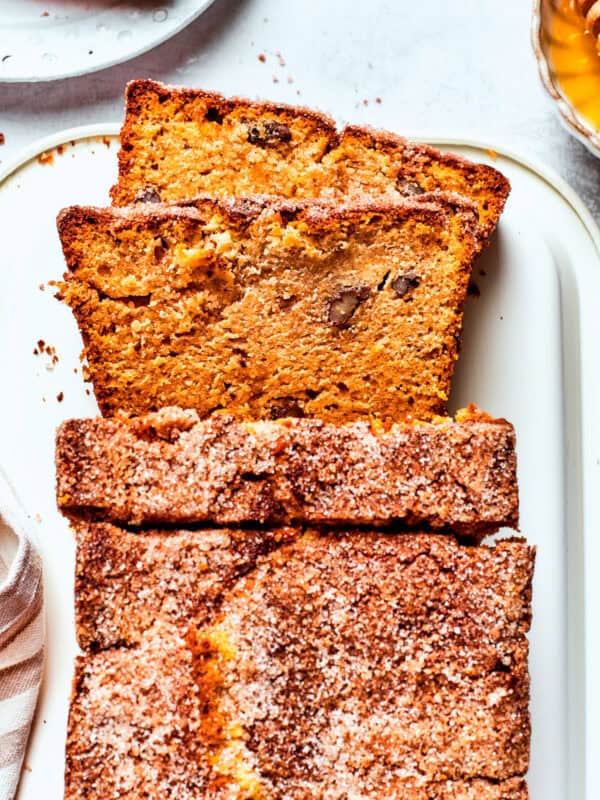
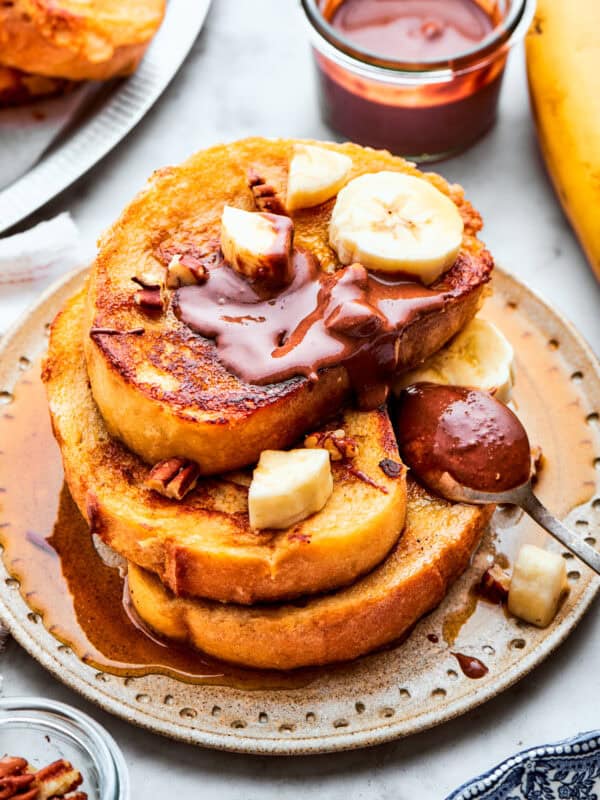

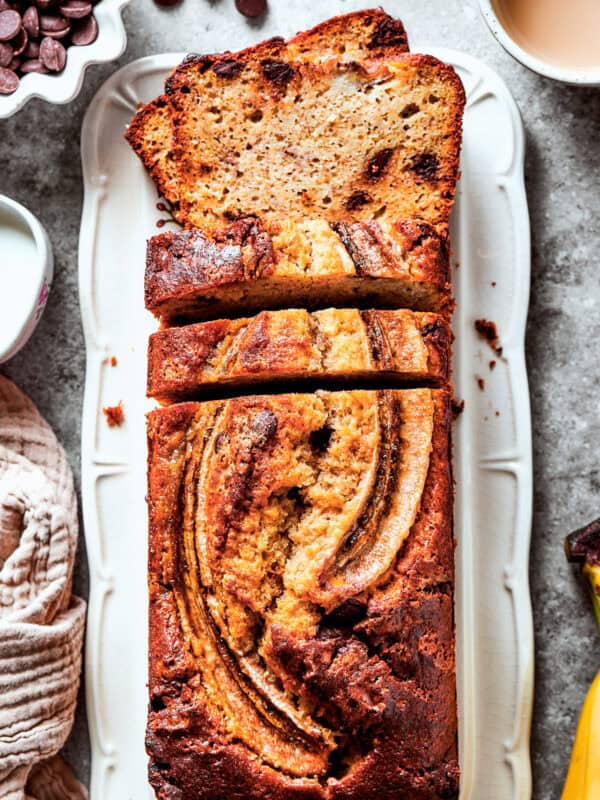








Can you freeze the dough and use at a later time?
Yes, you can. Make the dough as instructed and let it rise for 1 hour, per the recipe. Once risen, form the dough into a ball, wrap it in plastic wrap, and then place it in a freezer-friendly container and keep it frozen for up to a month. When ready, thaw the frozen dough on the kitchen counter, and continue with the recipe.
I would like to use my enamel coated Dutch oven 6qt. & would like to ask a stupid question….the directions say to oil the bottom and sides of the pan well before adding the bread but I also noticed mention of parchment paper. Should I be doing both? Thanks for help in advance since this is my first attempt!
Hi!
Not stupid at all. That is exactly what I do when using a Dutch oven to make this bread. ☺️
Can I use a Dutch oven instead of a cast iron skillet?
Hi!
I suggest following this no-knead bread recipe for baking bread in a Dutch oven: https://easyweeknightrecipes.com/no-knead-dutch-oven-bread/
so I have several cast iron fry pans and standard measurement is across the rim not the bottom. You call for an 8 inch skillet which I now have this lovely dough in for the last 30 min rise before the oven and it is already WAY over the top. Could you possibly have meant 8 inch as 8 inch across the bottom which is actually 10.25 inches across the rim on a Lodge cast iron skillet? Thanks!
I am currently making this bread, it sounds amazing! I wasn’t able to incorporate all the flour and it is really stiff and shaggy. I hope my yeast is active. I had to hand work as much of the flour in as I could. I’m so afraid it will be so dense. I have never made bread before. Is the dough supposed to be like that, really stiff? My kitchen is cold too, will that make a difference?
Hi!
A shaggy dough is normal, especially in the initial stages of mixing. If the dough feels excessively stiff and you’re struggling to incorporate all the flour, it’s perfectly fine to add a tablespoon of liquid (like water or milk) at a time until it reaches a more workable consistency. As for your yeast, as long as it’s not expired and was frothy when you activated it, it should be fine. The temperature of your kitchen can indeed affect bread making. Yeast thrives in a warm environment, so a colder kitchen might slow down the rising process.
This bread is SO GOOD – our family loves to pair it with just about anything!
So happy you love it! We do, too, and we just had it last weekend with soup and salad. 😃
I’m in love with this bread! I served it with my chicken fettuccini, and it was a huge hit. I really love not having to knead it until my arms fall off! LOL.
It’s always a bonus when you can enjoy delicious homemade bread without turning it into an arm workout, right? 😄 I’m glad you enjoyed it!
Oh my gosh, was this ever delicious, still warm with a little bit of butter – yum!
I’m so glad to hear you enjoyed it, especially warm with a touch of butter! That does sound delicious. Thanks for sharing your experience!
Great recipe – we will make it again soon! Easy to make and so delicious!
That’s fantastic to hear! I’m glad you found the recipe both easy and delicious. Enjoy making it again soon!
So tasty! We made this on spaghetti night and the kids loved it!
That’s wonderful! I’m so glad it was a hit with your family. Thank YOU! 🙂